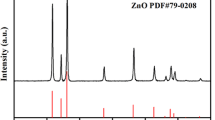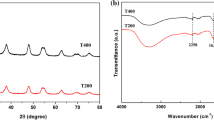Abstract
Mycotoxin contamination is a serious threat to food safety and human health. The development of efficient degradation strategies targeting mycotoxins is valuable. In this paper, magnetic TiO2@SiO2 hybrid photonic crystal microspheres (MHPCMs) were designed and prepared by the water-in-oil droplet method through a simple two-phase home-made microfluidic device for the degradation of deoxynivalenol (DON), the most serious mycotoxin contaminating cereals and feeding samples among natural mycotoxins. The morphologies of the synthesized microspheres were investigated by both metallurgical microscope and scanning electronic microscope (SEM), confirming that MHPCMs have a spherical shape and regular photonic crystal nanostructures. In the self-assembly system, TiO2 and Fe3O4 nanoparticles were responsible to form photocatalytic sites and magnet response, respectively. The effect of the TiO2 and Fe3O4 contents in the microspheres on their morphology and photocatalytic degradation activity was studied in detail. Finally, the optimized MHPCM could degrade DON in water under the light irradiation and be recycled easily by magnet.







Similar content being viewed by others
References
J.M. Misihairabgwi, C.N. Ezekiel, M. Sulyok, G.S. Shephard, R. Krska, Mycotoxin contamination of foods in Southern Africa: a 10-year review (2007–2016). Crit Rev Food Sci 59(1), 43–58 (2019). https://doi.org/10.1080/10408398.2017.1357003
F. Berthiller, M. Sulyok, R. Krska, R. Schuhmacher, Chromatographic methods for the simultaneous determination of mycotoxins and their conjugates in cereals. Int J Food Microbiol 119(1–2), 33–37 (2007). https://doi.org/10.1016/j.ijfoodmicro.2007.07.022
J.W. Bennett, M. Klich, Mycotoxins. Clin Microbiol Rev 16(3), 497–516 (2003). https://doi.org/10.1128/Cmr.16.3.497-516.2003
H.K. Knutsen, J. Alexander, L. Barregard, M. Bignami, B. Bruschweiler et al., Risks to human and animal health related to the presence of deoxynivalenol and its acetylated and modified forms in food and feed. Efsa J 15(9), 1–345 (2017). https://doi.org/10.2903/J.Efsa.2017.4718
B.M. Flannerya, K.Y. He, J.J. Pestka, Deoxynivalenol-induced weight loss in the diet-induced obese mouse is reversible and PKR-independent. Toxicol Lett 221(1), 9–14 (2013). https://doi.org/10.1016/j.toxlet.2013.05.008
I. Alassane-Kpembi, O. Puel, I.P. Oswald, Toxicological interactions between the mycotoxins deoxynivalenol, nivalenol and their acetylated derivatives in intestinal epithelial cells. Arch Toxicol 89(8), 1337–1346 (2015). https://doi.org/10.1007/s00204-014-1309-4
F.E. Wettstein, T.D. Bucheli, Poor elimination rates in waste water treatment plants lead to continuous emission of deoxynivalenol into the aquatic environment. Water Res 44(14), 4137–4142 (2010). https://doi.org/10.1016/j.watres.2010.05.038
D.R. Lauren, W.A. Smith, Stability of the Fusarium mycotoxins nivalenol, deoxynivalenol and zearalenone in ground maize under typical cooking environments. Food Addit Contam 18(11), 1011–1016 (2001). https://doi.org/10.1080/02652030110052283
M.C. Gruda, K.G. Ruggeberg, P. O’Sullivan, T. Guliashvili, A.R. Scheirer et al., Broad adsorption of sepsis- related PAMP and DAMP molecules, mycotoxins, and cytokines from whole blood using CytoSorb (R) sorbent porous polymer beads. PLoS ONE 13(1), e0191676 (2018). https://doi.org/10.1371/journal.pone.0191676
J.M. Gonzalez-Jartin, L.D. Alves, A. Alfons, Y. Pineiro, S.Y. Vilar et al., Detoxification agents based on magnetic nanostructured particles as a novel strategy for mycotoxin mitigation in food. Food Chem 294, 60–66 (2019). https://doi.org/10.1016/j.foodchem.2019.05.013
Y.H. Cheng, M.H. Chang, Y.A. Lin, J.F. Wu, B.J. Chen, Effects of deoxynivalenol and degradation enzyme on growth performance and immune responses in mule ducks. J Anim Feed Sci 13(2), 275–287 (2004)
A.C.P. Feltrin, S.D. Garcia, S.S. Caldas, E.G. Primel, E. Badiale-Furlong, J. Garda-Buffon, Characterization and application of the enzyme peroxidase to the degradation of the mycotoxin DON. J Environ Sci Heal B 52(10), 777–783 (2017). https://doi.org/10.1080/03601234.2017.1356672
S.L. Xiong, X. Li, C.S. Zhao, J.Q. Gao, W.J. Yuan, J. Zhang, The degradation of deoxynivalenol by using electrochemical oxidation with graphite electrodes and the toxicity assessment of degradation products. Toxins 11(8), 478 (2019). https://doi.org/10.3390/Toxins11080478
R.Y. Zhu, K. Feussner, T. Wu, F.J. Yan, P. Karlovsky, X.D. Zheng, Detoxification of mycotoxin patulin by the yeast Rhodosporidium paludigenum. Food Chem 179, 1–5 (2015). https://doi.org/10.1016/j.foodchem.2015.01.066
G. Wang, Y.X. Wang, F. Ji, L.M. Xu, M.Z. Yu et al., Biodegradation of deoxynivalenol and its derivatives by Devosia insulae A16. Food Chem 276, 436–442 (2019). https://doi.org/10.1016/j.foodchem.2018.10.011
J. Zhang, Y. Liu, Q. Li, X. Zhang, J.K. Shang, Antifungal activity and mechanism of palladium-modified nitrogen-doped titanium oxide photocatalyst on agricultural pathogenic fungi Fusarium graminearum. Acs Appl Mater Inter 5(21), 10953–10959 (2013). https://doi.org/10.1021/am4031196
S.M. Sun, R. Zhao, Y.L. Xie, Y. Liu, Photocatalytic degradation of aflatoxin B-1 by activated carbon supported TiO2 catalyst. Food Control 100, 183–188 (2019). https://doi.org/10.1016/j.foodcont.2019.01.014
H.T. Wang, J. Mao, Z.W. Zhang, Q. Zhang, L.X. Zhang et al., Photocatalytic degradation of deoxynivalenol over dendritic-like -Fe2O3 under visible light irradiation. Toxins 11(2), 105 (2019). https://doi.org/10.3390/Toxins11020105
X.J. Bai, H.Y. Li, Z.Y. Zhang, X.R. Zhang, C. Wang et al., Carbon nitride nested tubes with graphene as a dual electron mediator in Z-scheme photocatalytic deoxynivalenol degradation. Catal Sci Technol 9(7), 1680–1690 (2019). https://doi.org/10.1039/c9cy00209j
Y. Zhou, S. Wu, F. Wang, Q. Li, C. He et al., Assessing the toxicity in vitro of degradation products from deoxynivalenol photocatalytic degradation by using upconversion nanoparticles@TiO2 composite. Chemosphere 238, 124648 (2020). https://doi.org/10.1016/j.chemosphere.2019.124648
X.J. Bai, C.P. Sun, D. Liu, X.H. Luo, D. Li et al., Photocatalytic degradation of deoxynivalenol using graphene/ZnO hybrids in aqueous suspension. Appl Catal B 204, 11–20 (2017). https://doi.org/10.1016/j.apcatb.2016.11.010
Q. Yang, M.Z. Li, J. Liu, W.Z. Shen, C.Q. Ye et al., Hierarchical TiO2 photonic crystal spheres prepared by spray drying for highly efficient photocatalysis. J Mater Chem A 1(3), 541–547 (2013). https://doi.org/10.1039/c2ta00060a
B.F. Xin, Z.Y. Ren, P. Wang, J. Liu, L.Q. Jing, H.G. Fu, Study on the mechanisms of photoinduced carriers separation and recombination for Fe3+-TiO2 photocatalysts. Appl Surf Sci 253(9), 4390–4395 (2007). https://doi.org/10.1016/j.apsusc.2006.09.049
A.M. El Nahrawy, A.B. Abou Hammad, A.M. Bakr, T.I. Shaheen, A.M. Mansour, Sol–gel synthesis and physical characterization of high impact polystyrene nanocomposites based on Fe(2)O(3)doped with ZnO. Appl Phys A (2020). https://doi.org/10.1007/s00339-020-03822-w
H. Inan, M. Poyraz, F. Inci, M.A. Lifson, M. Baday et al., Photonic crystals: emerging biosensors and their promise for point-of-care applications. Chem Soc Rev 46(2), 366–388 (2017). https://doi.org/10.1039/c6cs00206d
W. Li, X.R. Zhu, X. Wang, J. Liu, B.W. Liang et al., A rapid, sensitive and real-time monitoring of alcohol content in spirit sample based on stable TiO2-coated porous silicon interferometer. Sensor Actuat B 281, 359–365 (2019). https://doi.org/10.1016/j.snb.2018.10.106
J. Xu, W. Li, R. Liu, Y. Yang, Q.X. Lin et al., Ultrasensitive low-background multiplex mycotoxin chemiluminescence immunoassay by silica-hydrogel photonic crystal microsphere suspension arrays in cereal samples. Sensor Actuat B-Chem 232, 577–584 (2016). https://doi.org/10.1016/j.snb.2016.03.123
J. Yu, J.Y. Lei, L.Z. Wang, J.L. Zhang, Y.D. Liu, TiO2 inverse opal photonic crystals: Synthesis, modification, and applications - A review. J Alloy Compd 769, 740–757 (2018). https://doi.org/10.1016/j.jallcom.2018.07.357
K. Hou, W. Ali, J.W. Lv, J. Guo, L. Shi et al., Optically active inverse opal photonic crystals. J Am Chem Soc 140(48), 16446–16449 (2018). https://doi.org/10.1021/jacs.8b10977
Y.Q. Zhang, L.D. Mu, R. Zhou, P. Li, J.Q. Liu et al., Fluoral-p infiltrated SiO2 inverse opal photonic crystals as fluorescent film sensors for detecting formaldehyde vapor. J Mater Chem C 4(41), 9841–9847 (2016). https://doi.org/10.1039/c6tc03862j
L. Zhou, J. Lei, L. Wang, Y. Liu, J. Zhang, Highly efficient photo-Fenton degradation of methyl orange facilitated by slow light effect and hierarchical porous structure of Fe2O3-SiO2 photonic crystals. Appl Catal B 237, 1160–1167 (2018). https://doi.org/10.1016/j.apcatb.2017.08.039
X. Zheng, D. Li, X. Li, L. Yu, P. Wang et al., Photoelectrocatalytic degradation of rhodamine B on TiO2 photonic crystals. Phys Chem Chem Phys 16(29), 15299–15306 (2014). https://doi.org/10.1039/c4cp01888e
S. Meng, D. Li, P. Wang, X. Zheng, J. Wang et al., Probing photonic effect on photocatalytic degradation of dyes based on 3D inverse opal ZnO photonic crystal. RSC Adv 3(38), 17021–17028 (2013). https://doi.org/10.1039/c3ra42618a
S.J. Wu, F. Wang, Q. Li, J. Wang, Y. Zhou et al., Photocatalysis and degradation products identification of deoxynivalenol in wheat using upconversion nanoparticles@TiO2 composite. Food Chem (2020). https://doi.org/10.1016/j.foodchem.2020.126823
L. Chen, Y.Z. Li, Y.B. Sun, Y. Chen, J.S. Qian, La(OH)(3) loaded magnetic mesoporous nanospheres with highly efficient phosphate removal properties and superior pH stability. Chem Eng J 360, 342–348 (2019). https://doi.org/10.1016/j.cej.2018.11.234
J.S. Fang, Y.W. Zhang, Y.M. Zhou, S. Zhao, C. Zhang et al., Synthesis of novel ultrasmall Au-loaded magnetic SiO2/carbon yolk-shell ellipsoids as highly reactive and recoverable nanocatalysts. Carbon 121, 602–611 (2017). https://doi.org/10.1016/j.carbon.2017.06.022
R. Kaplan, B. Erjavec, G. Drazic, J. Grdadolnik, A. Pintar, Simple synthesis of anatase/rutile/brookite TiO2 nanocomposite with superior mineralization potential for photocatalytic degradation of water pollutants. Appl Catal B 181, 465–474 (2016). https://doi.org/10.1016/j.apcatb.2015.08.027
N. Mandzy, E. Grulke, T. Druffel, Breakage of TiO2 agglomerates in electrostatically stabilized aqueous dispersions. Powder Technol 160(2), 121–126 (2005). https://doi.org/10.1016/j.powtec.2005.08.020
L.J. Duan, N. Jiang, N. Lu, K.F. Shang, J. Li, Y. Wu, Synergetic effect of TiO2 and Fe3+ as co-catalysts for enhanced phenol degradation in pulsed discharge system. Appl Catal B 221, 521–529 (2018). https://doi.org/10.1016/j.apcatb.2017.09.047
C. Wang, H.S. Shi, Y. Li, Synthesis and characteristics of natural zeolite supported Fe3+-TiO2 photocatalysts. Appl Surf Sci 257(15), 6873–6877 (2011). https://doi.org/10.1016/j.apsusc.2011.03.021
Acknowledgements
The project was funded by National Natural Science Foundation of China (Grant Nos. 31471642, 31071542 and 21705073), the Pig Innovation Team Plan of Modern Agricultural Technology System of Shandong Province (Grant No. SDAIT-08-17), and the National Key Research and Development Project of China (Grant No. 2019YFC1606404).
Author information
Authors and Affiliations
Corresponding author
Ethics declarations
Conflict of interest
All the authors declare no conflict of interests.
Additional information
Publisher's Note
Springer Nature remains neutral with regard to jurisdictional claims in published maps and institutional affiliations.
Rights and permissions
About this article
Cite this article
Li, Q., Deng, Y., Dai, S. et al. Microfluidic Assembly Synthesis of Magnetic TiO2@SiO2 Hybrid Photonic Crystal Microspheres for Photocatalytic Degradation of Deoxynivalenol. J Inorg Organomet Polym 31, 2360–2367 (2021). https://doi.org/10.1007/s10904-020-01806-0
Received:
Accepted:
Published:
Issue Date:
DOI: https://doi.org/10.1007/s10904-020-01806-0




